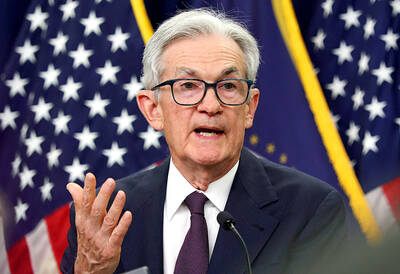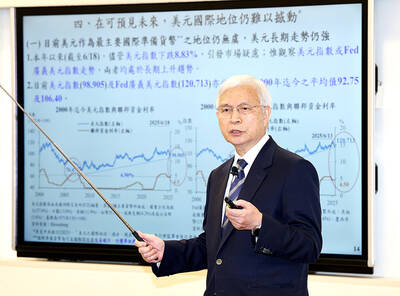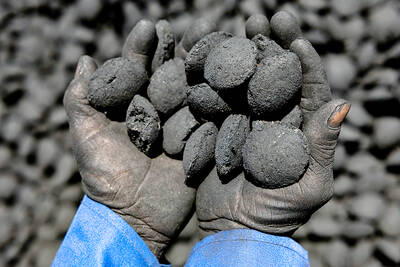Talks to negotiate a lower price for Pfizer Inc’s COVID-19 antiviral pill Paxlovid in China did not pan out, the Chinese National Healthcare Security Administration on Sunday said, creating a quandary for the Chinese government amid a rampant outbreak in the world’s most populous nation.
Pfizer and the government agency that oversees the state medical insurance program failed to agree on a further cut on the price of Paxlovid, which initially sold for 2,300 yuan (US$340) and was recently lowered to about 1,900 yuan for a course of treatment, Chinese news reports said.
The pill is covered by state medical insurance under a provisional measure, which would continue until the end of March, the agency said in a statement.

Photo: REUTERS
The government remains in talks with Pfizer for a licensing deal to allow domestic companies to manufacture generic versions of Paxlovid, Reuters reported on Saturday.
Although five Chinese companies make inexpensive, generic versions of Paxlovid for low-income countries under an agreement with the UN-backed Medicines Patent Pool, they cannot sell the output in China.
Pfizer’s unwillingness to further reduce Paxlovid’s price underscores the challenge Beijing faces in getting US and European drugmakers to help ease its strain in dealing with a COVID-19 wave that has overwhelmed hospitals and caused medicine shortages.
Pfizer would continue to collaborate with the government and other stakeholders to secure an adequate supply of Paxlovid in China, even though negotiations for state insurance coverage did not work out, the New York-based drugmaker said in a statement yesterday.
Given China’s under-developed private medical insurance market and the reliance of its 1.4 billion people on the state-run program, Beijing has been dangling inclusion on government’s reimbursement list to push drugmakers to offer deep cost cuts.
Every year it negotiates to set prices for newly approved and life-saving medicines that are part of the 2.87 trillion yuan state program, which covers more than 95 percent of the population.
Companies ranging from AstraZeneca PLC and GSK PLC to Gilead Sciences Inc and Pfizer have participated, as the expanded sales volume stemming from the insurance coverage can more than offset the reduced revenue from price cuts.
The approach means some drugs in China cost a faction of their price in developed countries.
While China has relied exclusively on domestically produced vaccines for most of the COVID-19 pandemic, Beijing has demonstrated a greater appetite for antiviral therapies developed abroad following the country’s abrupt termination of its “zero COVID-19” approach last month.
After Paxlovid was approved early last year, state-owned China Meheco Co (中國醫藥) struck a deal to import and distribute more of it to meet surging demand.
Pfizer has also reached deals with two Chinese manufacturers to produce the drug’s ingredients locally. China’s drug regulator approved Merck & Co’s antiviral Lagevrio late last month.
The state-run health insurance program extended coverage to the home-grown COVID-19 antiviral azvudine and traditional Chinese herbal medicine granules, but neither demonstrated the same ability to prevent severe disease and death in clinical trials as Paxlovid.
Supply of the Pfizer drug in China has fallen significantly short of the demand for it, a situation exacerbated by the comparatively low rates of vaccination among elderly people, who are at greater risk of severe disease or death.
Many people have turned to the black market, buying the drug from other countries or bringing in generic versions made in India.

DIVIDED VIEWS: Although the Fed agreed on holding rates steady, some officials see no rate cuts for this year, while 10 policymakers foresee two or more cuts There are a lot of unknowns about the outlook for the economy and interest rates, but US Federal Reserve Chair Jerome Powell signaled at least one thing seems certain: Higher prices are coming. Fed policymakers voted unanimously to hold interest rates steady at a range of 4.25 percent to 4.50 percent for a fourth straight meeting on Wednesday, as they await clarity on whether tariffs would leave a one-time or more lasting mark on inflation. Powell said it is still unclear how much of the bill would fall on the shoulders of consumers, but he expects to learn more about tariffs

NOT JUSTIFIED: The bank’s governor said there would only be a rate cut if inflation falls below 1.5% and economic conditions deteriorate, which have not been detected The central bank yesterday kept its key interest rates unchanged for a fifth consecutive quarter, aligning with market expectations, while slightly lowering its inflation outlook amid signs of cooling price pressures. The move came after the US Federal Reserve held rates steady overnight, despite pressure from US President Donald Trump to cut borrowing costs. Central bank board members unanimously voted to maintain the discount rate at 2 percent, the secured loan rate at 2.375 percent and the overnight lending rate at 4.25 percent. “We consider the policy decision appropriate, although it suggests tightening leaning after factoring in slackening inflation and stable GDP growth,”

Meta Platforms Inc offered US$100 million bonuses to OpenAI employees in an unsuccessful bid to poach the ChatGPT maker’s talent and strengthen its own generative artificial intelligence (AI) teams, OpenAI CEO Sam Altman has said. Facebook’s parent company — a competitor of OpenAI — also offered “giant” annual salaries exceeding US$100 million to OpenAI staffers, Altman said in an interview on the Uncapped with Jack Altman podcast released on Tuesday. “It is crazy,” Sam Altman told his brother Jack in the interview. “I’m really happy that at least so far none of our best people have decided to take them

As they zigzagged from one machine to another in the searing African sun, the workers were covered in black soot. However, the charcoal they were making is known as “green,” and backers hope it can save impoverished Chad from rampant deforestation. Chad, a vast, landlocked country of 19 million people perched at the crossroads of north and central Africa, is steadily turning to desert. It has lost more than 90 percent of its forest cover since the 1970s, hit by climate change and overexploitation of trees for household uses such as cooking, officials say. “Green charcoal” aims to protect what